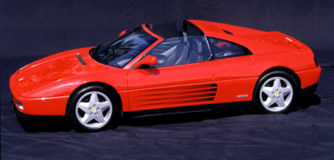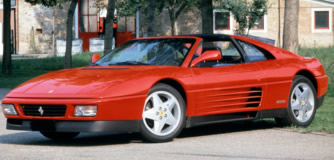|
In the autumn of 1989 the era of the transverse V8 engined Ferrari range, which had started with the presentation of the Dino 308 GT4 at the Paris Salon in October 1973, reached the end of the road when the
328 series ceased production. The replacement was the all new 348 model, presented at the 1989 Frankfurt Salon, fitted with a longitudinally mid-mounted V8 engine, initially available in tb ("b" for berlinetta) or ts ("s" for
spider, but actually a targa top) form. The 348 in the model name referred to the 3.4 litre engine capacity and eight cylinders, whilst the "t" in the designation referred to the transverse gearbox mounted at the rear
of the engine. This was the first completely new model announced by the company subsequent to the death of Enzo Ferrari in August 1988.
The engine was a twin overhead camshaft per bank, four valves per cylinder, 3.4
litre V8 unit, initially with factory type reference 119D, then 119 G, and finally 119 G040 when fitted with catalytic converters. It had a total cubic capacity of 3405cc, and a bore and stroke of 85mm x 75mm, with spark plugs
between the camshafts, fitted with a Bosch Motronic M2.5 combined fuel injection and ignition system, which was upgraded to the M2.7 version during the production run. At the rear of the mid mounted engine was a transverse five
speed plus reverse all synchromesh gearbox and transaxle unit.
The new model was a radical departure from the design philosophy of its predecessor, not only in the mechanical layout, but also in the style of the body,
and the chassis construction. Along with the sister 348 ts model, this was the first series production Ferrari not to have a separate tubular steel chassis frame. Instead it used a pressed steel chassis, with a separate tubular
steel engine sub-frame bolted to it, with the body panels robot welded, and bolted, to the main structure. The wheelbase was 100mm more than the 328 model that it succeeded at 2450mm, and the chassis carried factory type
reference F 119 AB on the berlinetta. The body was designed by Pininfarina, and bore a strong family resemblance to the Testarossa model, but on a smaller scale. The similarities are particularly noticeable in the horizontally
straked air inlets in the door ducts to the side mounted radiators, and the rear light treatment, where the lenses are hidden behind a full width matt black slatted grille. When the Testarossa was given a facelift in 1992 to
become the 512 TR, the new nose treatment used was very similar in style to that of the 348 models, making the likeness even greater. On both models the front "radiator grille" was a dummy inset satin black egg crate pattern
unit, to provide the traditional Ferrari face. The alloy wheels maintained the traditional Ferrari five spoke design, with five bolt fixing, but with an aerodynamic spoke profile unique to this series of models.
The
interior featured a pair of leather trimmed seats with manual adjustment, featuring supportive side bolsters, adjustable head restraints and three point inertia reel seat belts. The main instruments were housed in a deep
binnacle ahead of the three spoke leather trimmed steering wheel, whilst on the passenger side a glove box was provided in the dash face. Between the seats there was a centre console running into the lower edge of the
dashboard, incorporating ancillary instrumentation and switchgear, together with the gear lever in the traditional open gate. Electrically operated windows and door mirrors were provided, whilst the latter had heating elements,
which were actuated by the rear screen demister switch.
In 1993 a Challenge Race Series was inaugurated for the 348 models. In this, clients paid a set fee for a safety/performance kit and track support for the season.
This series proved very popular, and evolved into that for the F355 models that succeeded the 348 series. During 1995 both series of cars were allowed to participate during the model changeover period. The 348 tb model ceased
production in 1993 with the announcement of the updated 348 GTB, during the production period 2894 examples were produced in the chassis number range 81617 to 96679.
 
348 TS
The convertible version of the 348 TB, with a removable hard top, was powered by the same drive-train as
the berlinetta version, giving it equivalent performance. The body was again styled by Pininfarina. The impressive dynamic characteristics of both versions were so ideally suited to the race track that in 1993 a
Challenge was established especially for these cars, thus continuing Ferrari's long-standing privateer racing tradition.
The 348 ts model was presented concurrently with fixed roof 348 tb at the 1989 Frankfurt Salon, and was fitted with a longitudinally mid-mounted V8 engine. The 348 in the model name referred to the 3.4 litre engine
capacity and eight cylinders, whilst the "t" in the designation referred to the transverse gearbox mounted at the rear of the engine.
The engine was a twin overhead camshaft per bank, four valves per cylinder, 3.4 litre V8 unit, initially with factory type reference 119D, then 119 G, and finally 119 G040 when fitted with catalytic converters. It had
a total cubic capacity of 3405cc, and a bore and stroke of 85mm x 75mm, with spark plugs between the camshafts, fitted with a Bosch Motronic M2.5 combined fuel injection and ignition system, which was
upgraded to the M2.7 version during the production run. At the rear of the mid mounted engine was a transverse five speed plus reverse all synchromesh gearbox and transaxle unit.
The new model was a radical departure from the design philosophy of its predecessor, not only in the mechanical layout, but also in the style of the body, and the chassis construction. Along with the sister 348
tb model this was the first series production Ferrari not to have a separate tubular steel chassis frame. Instead it used a pressed steel chassis, with a separate tubular steel engine sub-frame bolted to it, with the
body panels robot welded, and bolted, to the main structure. The wheelbase was 2450mm, and the chassis carried factory type reference F 119 AS on the ts model. The Pininfarina designed body was essentially the
same as the one on the fixed head 348 tb model, apart from the solid removable roof panel, which could be stowed under a cover behind the seats when not in use. Similarly, the interior was virtually identical to that
of the concurrent 348 tb model, apart from the stowage facility for the roof behind the seats.
As with the 348 tb this targa roof model was also eligible to run in the Challenge Race Series for the 348
models, in which clients paid a set fee for a safety/performance kit and track support for the season. The 348 ts model ceased production in 1993 with the announcement of the updated 348 GTS, during the
production period a total of 4228 examples were produced in the chassis number range 81651 to 96964, which was approximately one third more than the fixed roof model.
Engine
Type.................................rear, longitudinal 90° V8
Bore/stroke.........................85 x 75 mm
Unitary displacement............425.59 cc
Total displacement...............3404.70 cc
Compression ratio................10.4 : 1
Maximum power...................221 kW (300 hp) at 7200 rpm
Power per litre.....................88 hp/l
Maximum torque..................324 Nm (33 kgm) at 4200 rpm
Valve actuation...................twin overhead camshafts per bank, four valves per cylinder
Fuel feed............................Bosch Motronic electronic injection
Ignition..............................Bosch static electronic, single spark plug per cylinder
Lubrication.........................dry sump
Clutch...............................twin-plate
Chassis
Frame................................steel monococque with tubular steel rear sub-frame
Front/Rear suspension...........independent, unequal-length wishbones,
coil springs over gas-filled telescopic shock absorbers, anti-roll bar
Brakes...............................discs
Transmission.......................5-speed + reverse
Steering.............................rack-and-pinion
Fuel tank............................capacity 95 litres
Front tyres.........................215/50 ZR 17
Rear tyres..........................255/50 ZR 17
Bodywork
Type.................................two-seater berlinetta or two-seater targa-top
Length...............................4230 mm
Width................................1894 mm
Height...............................1170 mm
Wheelbase..........................2450 mm
Front track.........................1502 mm
Rear track..........................1578 mm
Weight..............................1393 kg (dry)
Performance
Top speed..........................over 275 km/h
Acceleration
0-100 km/h........................5.6 sec
0-1000 m...........................24.7 sec
<1980
|